|
Have a safe day!
Thursday, July 22
2:30 p.m.
Theoretical Physics Seminar - Curia II
Speaker: Jan Winter, Fermilab
Title: New Algorithms to Compute Virtual and Tree-Level Amplitudes
3:30 p.m.
DIRECTOR'S COFFEE BREAK - 2nd Flr X-Over
4 p.m.
Accelerator Physics and Technology Seminar - One West
Speaker: Hamid Aït Abderrahim, Belgian Nuclear Research Centre
Title: MYRRHA - A Multi-National Demonstration Program for Incineration of Spent Nuclear Fuel Wastes: Status of MYRRHA and ISOL@MYRRHA in March 2010
Friday, July 23
3:30 p.m.
DIRECTOR'S COFFEE BREAK - 2nd Flr X-Over
4 p.m.
Joint Experimental-Theoretical Physics Seminar - One West
Speaker: Rex Tayloe, Indiana University
Title: Neutrino-nucleon quasielastic scattering in MiniBooNE
Click here for NALCAL,
a weekly calendar with links to additional information.
Upcoming conferences |
|
For information about H1N1, visit Fermilab's flu information site.
|
|
Thursday, July 22
- Breakfast: apple sticks
- Santa Fe black bean soup
- Steak tacos
- Chicken Wellington
- Chimichangas
- Baked ham and Swiss on a ciabatta roll
- Assorted sliced pizza
- Smart cuisine: crispy fried chicken salad
Wilson Hall Cafe Menu
|
|
Thursday, July 22
Dinner
- Corn cakes w/ shrimp & chipotle
- Fillet of beef w/ morel sauce
- Potato gratin
- Chive green beans
- Mocha soufflé
Wednesday, July 28
Lunch
- Beef kabobs
- Rice pilaf
- Blackberry parfait
Chez Leon Menu
Call x3524 to make your reservation.
|
|
|
Particles prefer diamonds
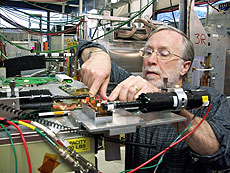 |
Bob Stone of Rutgers University working on a prototype of the Pixel Luminosity Telescope during a beam test at Fermilab last spring. |
Diamonds are no longer just a girl's best friend. These solid gemstones will soon work their way into the heart of the CMS detector's new Pixel Luminosity Telescope detector, currently under construction at Rutgers and Princeton Universities.
For now, the CMS experiment at CERN uses the far-forward hadron calorimeter to monitor luminosity. The PLT, on the other hand, is a dedicated luminosity monitor that will provide more precise and stable measurements of the intensity of particle collisions inside the detector. The PLT, which consists of 16 telescopes with eight on either end of the detector, will sit just one centimeter away from the beamline and two meters from the point where protons collide.
And that's where the diamonds come in.
"You need to be close to the beamline in order to get a good measurement, and this puts the telescope in a harsh environment," said Steve Schnetzer, a physicist at Rutgers University.
Scientists classify diamonds as "radiation hard" because of their ability to withstand lengthy exposures to radiation without losing their luster. Schnetzer explained that the use of diamonds in the PLT marks the first time that the gemstones will be used as a tracking device in a full-scale experiment. He estimates that the diamonds should last through the experiment's lifetime.
As another bonus, diamonds operate at room temperature and eliminate the need for cooling lines--an important requirement given the tight space around the beam pipe in the detector.
"Diamonds make the whole project feasible," Schnetzer said.
Once the PLT has been in operation for some time, the data obtained from it will help scientists to determine if diamond sensors are suitable for use in future upgrades of the CMS detector.
In addition to Rutgers and Princeton, scientists from CERN, Fermilab, Vanderbilt University, the Institute for High Energy Physics in Vienna and Canterbury University in New Zealand are collaborating on the PLT project. The team expects to complete the detector in November.
-- Elizabeth Clements
|
Lupe Rodriguez, electronics assembly specialist, retires
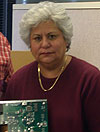 |
| Lupe Rodriguez |
In 1971, Guadalupe (Lupe) Rodriguez took a position in Fermilab's Research Division printed circuit board fabrication shop. After 39 years, Rodriguez, who currently works in PPD's Electrical Engineering Department, will retire.
"Lupe is a very hard worker who takes pride in everything she does," said PPD's Curtis Danner, Rodriguez's current supervisor.
Rodriguez's increasing knowledge and experience with printed circuit boards soon earned her responsibility for the shop's day-to-day operations. She handled the high-priority, fast-turnaround orders and the technical challenges presented by physicists and engineers, who developed new methods to integrate the circuit boards into particle detector assemblies. This resulted in demand for fabrication of unusual shapes, materials and sizes of printed circuit boards. Rodriguez's shop remained a valuable asset to the laboratory until it could no longer keep up with changing state-of-the-art technologies. Rodriguez then joined the Research Division's instrumentation group, where she worked on electronics assembly and repair.
“Knowing that Lupe would apply her delicate touch to the assembly process allowed the engineers to push the limits on how tight the geometries could be for the electronics and associated beam detectors,” said Bob DeMaat, Rodriguez's department head.
When the Particle Physics Division formed in 1997, Rodriguez joined the electronics assembly and prototyping group, where she did a variety of work associated with electronics assembly, modifications and repair.
"Lupe was instrumental in developing the methods our assemblers now use to solder surface-mount-device components,” Danner said. “We tried a commercial ‘pick & place’ machine, but stopped using it when we determined that Lupe was more efficient soldering the components by hand!"
A retirement luncheon will take place in Rodriguez's honor at noon on Friday, July 23, at Fox’s On The River in Batavia. The $14 cost will include a buffet lunch and gift. Please R.S.V.P. to Carolyn Johnson at x4206 if you plan to attend.
-- Rhianna Wisniewski
|
Senate Appropriations Subcommittee completes DOE funding bill
From The AIP Bulletin of Science Policy News, July 21, 2010
The Senate Energy and Water Development Appropriations Subcommittee approved its FY 2011 funding bill yesterday. As was true for the bill drafted by the House Energy and Water Development Appropriations Subcommittee, few details are available.
Department of Energy:
FY 2010 appropriation: $27,111 million
FY 2011 Administration request: $29,613 million
House subcommittee recommendation: $28,109 million, an increase of $998 million or 3.7 percent above this year.
Senate subcommittee recommendation: $28,346 million, an increase of $1,235 million or 4.6 percent above this year.
Office of Science:
FY 2010 appropriation: $4,904 million
FY 2011 Administration request: $5,121 million
House subcommittee recommendation: $4,900 million, a decline of $4 million or 0.1 percent below this year.
Senate subcommittee recommendation: $5,012 million, an increase of $108 million or 2.2 percent above this year.
Read more
|
|
|
Tevatron to make big splash in Paris
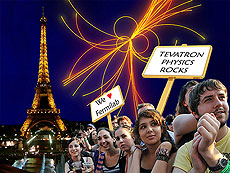 |
Particles and Paris: This Photoshopped image conveys the excitement that many feel for the talks that will be given at ICHEP. Credit: Parts of figure courtesy Joseph Mohan. Used with permission. |
Particle physics’ biggest conference began about seven hours ago. The 35th International Conference on High Energy Physics, or ICHEP, promises to be dramatic.
The conference began in 1950 and has met every two years since 1960. For us old-timers, this conference is also called "The Rochester Conference," so named because the first seven times it convened, it was held in Rochester, New York. Since then, it has roamed the globe, landing in cities from Singapore and Osaka to Chicago and Dallas. It is in the conference rooms of the various institutions in these cities that physicists have stood up and announced their discoveries and new theories. Many advances in our knowledge of the particle physics realm have had their first public hearing in talks given at this conference.
This year, physicists will give 600 presentations, covering the entire gamut of topics available to modern frontier physics, including dark matter and energy and the latest in the search for the elusive Higgs boson. The first results from the newly operating LHC are also expected to draw some attention.
But some of the biggest and most interesting results are those from the Tevatron. Physicists will present DZero analyses in 31 distinct lectures. Most of these lectures will include a combination of results from DZero and CDF. In addition, there are also some lectures that involve only DZero or only CDF measurements.
Last Friday, Fermilab residents got a look at some of the main Tevatron results that physicists will present at ICHEP in the Joint Experimental-Theoretical Physics seminar. In that seminar, Marco Verzocchi and Tom Wright presented DZero's and CDF's results for top quark properties, B quark mixing and, of course, the search for the Higgs, respectively. The results were diverse and the experimenters gratefully acknowledge the Fermilab community's role in making these measurements possible.
The halls of the conference venue are buzzing with excitement. Fermilab Today readers should stay tuned. There will be more reports from this interesting conference.
-- Don Lincoln
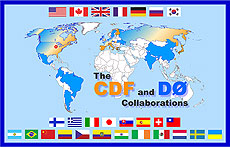 |
| The i in “ICHEP” stands for international. Even simply restricting ourselves to the countries participating in the DZero and CDF collaborations, we already see the international flavor of modern experimental particle physics. When all experiments are included, the overall effort takes place worldwide. |
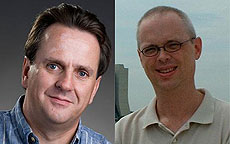 |
| Marco Verzocchi (left, Fermilab, DZero) and Tom Wright (right, University of Michigan, CDF) jointly presented a selection of the new results from the Tevatron that will be shown publicly over the upcoming week during the ICHEP conference. |
|
|